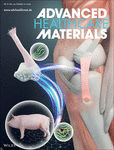|
Autores/as
Fornaguera, C. ; Guerra-Rebollo, M. ; Guerra-Rebollo, M. ; Lázaro, M. A. ; Lázaro, M. A. ; Cascante, A. ; Cascante, A. ; Rubio N.; Blanco J.;Borrós, S. ; Rubio N.; Blanco J.;Borrós, S.
|
Abstract
One of the main bottlenecks in the translation of nanomedicines from research to clinics is the difficulty in designing nanoparticles actively vectorized to the target tissue, a key parameter to ensure efficacy and safety. In this group, a library of poly(beta aminoester) polymers is developed, and it is demonstrated that adding specific combinations of terminal oligopeptides (OM‐PBAE), in vitro transfection is cell selective. The current study aims to actively direct the nanoparticles to the liver by the addition of a targeting molecule. To achieve this objective, retinol, successfully attached to OM‐PBAE, is selected as hepatic targeting moiety. It is demonstrated that organ biodistribution is tailored, achieving the desired liver accumulation. Regarding cell type transfection, antigen presenting cells in the liver are those showing the highest transfection. Thanks to proteomics studies, organ but not cellular biodistribution can be explained by the formation of differential protein coronas. Therefore, organ biodistribution is governed by differential protein corona formed when retinol is present, while cellular biodistribution is controlled by the end oligopeptides type. In summary, this work is a proof of concept that demonstrates the versatility of these OM‐PBAE nanoparticles, in terms of the modification of the biodistribution of OM‐PBAE nanoparticles adding active targeting moieties.
|

WoS
Scopus
Altmetrics
  
|
|
Publicación
Advanced Healthcare Materials, 2019, vol. 8, no. 18, art. no. 1900849
|
